New Year- a time of joyous renewal
By Kalakeerthi EDWIN ARIYADASA
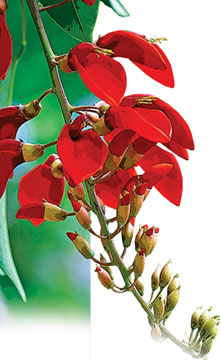 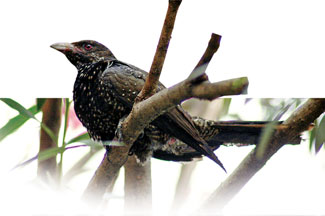 Our
Planet Earth orbits the Sun in a non-stop routine. This space drama has
gone on for billions of years. We who inhabit this Planet Earth keep on
orbiting the Sun, from birth to death. Our
Planet Earth orbits the Sun in a non-stop routine. This space drama has
gone on for billions of years. We who inhabit this Planet Earth keep on
orbiting the Sun, from birth to death.
The time taken by the Earth to complete one rotation round the Sun is
described as a year. Conventionally a year has 365 or 366 days, divided
into 12 months. Generally, the modern world calculates the year as the
period from January 1 to December 31. This is characterised as a
“calendar year”.
However, various people calculate the year in their own specific
terms. The indigenous system of Sri Lanka measures the year from April
12 of one year to April 13 of the next year. These dates may vary
slightly, but each year April 13/14 is celebrated as the day on which
the Sinhala and Hindu New Year dawns.
Rituals
This year (2011), astrologers have indicated that the main New Year
rituals should be observed on April 14.
The indigenous system assumes that the Sun “transits” from the
zodiacal sign Pisces to the zodiacal sign Aries, starting the New Year.
The ancients believed that the Sun orbited our home planet. For
centuries, the indigenous New Year celebrations were founded upon that
assumption.
However, the unassailable fact is that the New Year festival takes
precedence over all such occasions in Sri Lanka’s indigenous cultural
calendar. It is entrenched in our society as our primary festival, in
which almost everyone has a stake.
Incidentally the New Year is mankind’s oldest festival. It all began
right from man’s earliest days on earth. At the time man was intimately
linked with nature’s processes, especially the changing seasons
determined the routine of his life.
In spring, nature was aglow with life. The wooded world was all
green; rivers and streams, gurgling and roaring, hurried along,
sparkling in the sun. Warblers flitted about practising their songs
after some silence. Life quickened, instilling joy, elan and gusto into
the spirit of those early humans.
Bounty
Summer arrived, nursing them with its bounty. Hunting and gathering
ensured plenty and satiation. Then came the Fall-autumn. The lively
green leaves turned brown and fell on the earth, carpeting it. At this
“golden grove unleaving”, early man experienced a tinge of regret.
Finally, winter overwhelmed the earth. The bird-song was hushed.
Waterways fell silent and froze into white sheets. Trees withered into
twigs. Life seemed totally smothered.
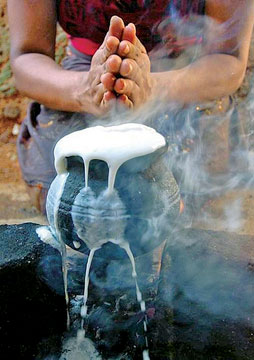 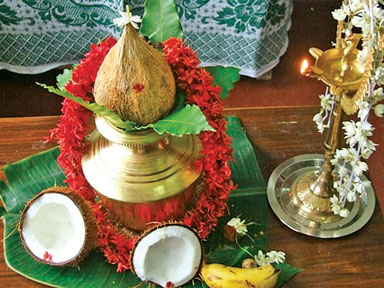 Assailed
and devastated by all this, man lamented the failure of nature. His only
explanation was, that, the “great being”, who kept his world alive and
glowing, has died. Early man went about mourning and weeping, saddened
by his vast loss. Assailed
and devastated by all this, man lamented the failure of nature. His only
explanation was, that, the “great being”, who kept his world alive and
glowing, has died. Early man went about mourning and weeping, saddened
by his vast loss.
But, lo and behold, in spring, the “Great One”, regained life. The
world again turned lush green and early man’s joy knew no bounds.
What is really remarkable is that these twin aspects are reflected in
all New Year festivals of our day.
The initial phase is a period of lamentation. In the second phase man
erupts with joy and begins a renewed life with the risen God of Nature.
In the age-old rituals of the Sinhala and Hindu New Year, these two
facets are vividly present. In the segment described as the “Old Year”
(Parana Avurudda), all pleasures are held in abeyance. The hearth is not
kindled. Food is not partaken of. Entertainment is shunned. People
indulge in religious pursuits. Today people performing these symbolic
acts of mourning may not know the reasons behind this ritual. This is
the distant echo of the wailing of the early man who was overwhelmed
with sadness at the “death” of nature.
Jubilation
When the second phase of the New Year dawns there is widespread
jubilation. The hearth is kindled afresh. Guests initiate new life by
partaking of the festive meal and by starting transactions. Every
routine of life begins afresh auspiciously and ritually.
In the Sinhala New Year festivities, the initial phase is described
as the Nonagathe, the neutral phase, Nonekatha. This is a reflection of
the death of the God of Nature, in the ancient system of belief.
In some places, strange rituals are performed to depict the loss of
Nature’s power. In some remote villages of the Western world, the
womenfolk tie up strong young men with ropes to symbolise the loss of
nature’s vigour.
But they are untied after a brief while to symbolise the joyous
revival of the power of nature. The menfolk of Sri Lanka should consider
themselves very fortunate that Nonagathe rituals do not reach such
extremes.
As most men and women of our day are so thoroughly alienated from the
origins of the New Year rituals, they are tempted to trot out fanciful
interpretations of such concepts as Nonagathe.
But, in the rural setting where I was born, the New Year was present
as a living and pulsating entity. I have orbited the sun for 88 years
and four months. I have seen 86 New Year festivals. In my childhood, the
spirit of New Year seeped deep into our total being. Joyous expectations
filled our childish souls. Mothers would prepare sweetmeats, imparting a
creativity to the domestic New Year ritual.
The New Year was an event close to Nature. Deep-red buds of erabadu
was a colourful advertisement announcing the arrival of the New Year.
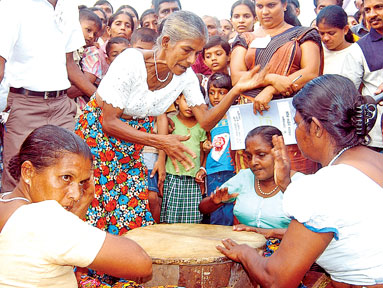 The
cuckoo’s song was a singing commercial, proclaiming that the new year
was nigh. The
cuckoo’s song was a singing commercial, proclaiming that the new year
was nigh.
Traditions
During my childhood, the New Year festival of our village was largely
folk-inspired and folk-sponsored. Tradition provided the people with
age-old rites and rituals.
Today, fortunately, the State, commercial interests and media
(especially electronic) have taken over the New Year. We should be
obliged to those institutions as they keep the masses attuned to
tradition, preventing the precious New Year culture from fading.
The New Year rituals unify nations. The temple bells reminded
villagers in the past about the ritual hours. Today television and radio
have taken over. The modern media have steadily worked towards
preserving our cultural heritage, especially those traits associated
with the New Year.
New Year rituals contribute substantially towards preserving such
human values as deference to elders and the pursuit of religious
practices. Family reunions strengthen the intimate relations that unite
people.
We have to discipline our people again to observe the New Year as an
ecological celebration and as a means of uniting people through love and
affection.
The New Year is a festival of peace that leads to harmonious
co-existence. Internal conflicts are resolved. The New Year should be
elevated to the level of a national ritual that will unite us as a
single nation.
|

